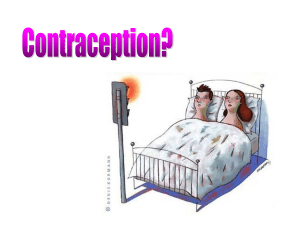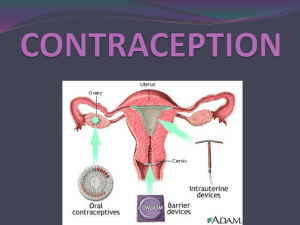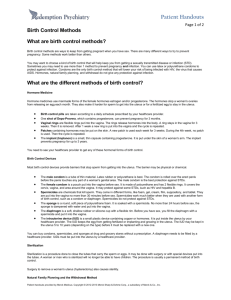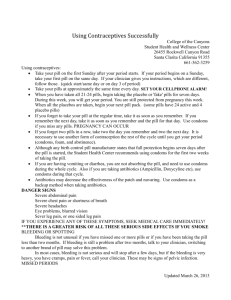Document
advertisement
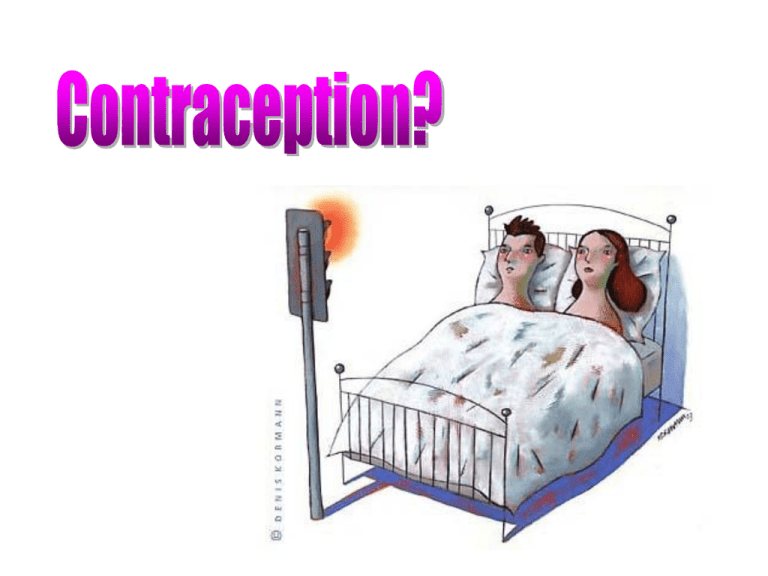
Teens & Birth Control: Excuses...Excuses...Excuses • • • • • • • “It was unromantic and planned” “I Would feel guilty” “It is against my religion” “We used the withdrawal method” “Doctor will blab to my mom” “It won’t happen to me” “Condoms break and don’t work” Teens & Pregnancy • 1 million teens became pregnant in 2000 • 512,000 of these teens gave birth • 6 of 10 U.S. pregnancies are unplanned • Most teens do not plan to have sex the first time forget to use a birth control method Estimated Annual Cases of STD’s (source: WHO) • 333 million worldwide • 15.3 million in U.S. Estimated Annual Cases of STDs, U.S. (American Social Health Association, Dec 1998, “STD’s: How many at at What Cost?”) • • • • • • • • • Human Papilloma Virus Tichomoniasis Chlamydia Herpes Gonorrhea Hepatitis B Syphilis HIV 5,500,000 5,000,000 3,000,000 1,000,000 650,000 77,000 70,000 20,000 total 15,317,000 Abstinence • Only 100% method of birth control • Abstinence is when partners do not engage in sexual intercourse • Communication between partners is important for those practicing abstinence to be successful Reasons for abstaining • • • • Moral or religious values Personal beliefs Medical reasons Not feeling ready for an emotional, intimate relationship • Future plans Types of Birth Control • • • • Hormonal Barrier IUD Methods based on information • Permanent sterilization R Hormonal Methods • Oral Contraceptives (Birth Control Pill) • Injections (Depo-Provera) • Implants (Norplant I & II) Birth Control Pills • • • • Pills can be taken to prevent pregnancy Pills are safe and effective when taken properly Pills are over 99% effective Women must have a pap smear to get a prescription for birth control pills • Pills DO NOT prevent STD’s How does the pill work? • Stops ovulation • Thins uterine lining • Thickens cervical mucus Positive Benefits of Birth Control Pills Prevents pregnancy Eases menstrual cramps Shortens period Regulates period Decreases incidence of ovarian cysts Prevents ovarian and uterine cancer Decreases acne Side-effects • Breast tenderness • Nausea • Increase in headaches • Moodiness • Weight change • Spotting Taking the Pill • • • • Once a day at the same time everyday Use condoms for first month Use condoms when on antibiotics Use condoms for 1 week if you miss a pill or take one late • The pill offers no protection from STD’s Depo-Provera • Birth control shot given once every three months to prevent pregnancy • 99.7% effective preventing pregnancy • No daily pills to remember How does the shot work? • • • • The same way as the Pill! Stops ovulation Stops menstrual cycles!! Thickens cervical mucus SIDE EFFECTS • Extremely irregular menstrual bleeding and spotting for 3-6 months! • NO PERIOD after 3-6 months • Weight change • Breast tenderness • Mood change *NOT EVERY WOMAN HAS SIDE-EFFECTS! The Patch The Patch IMPLANTS • Implants are placed in the body filled with hormone that prevents pregnancy • Physically inserted in simple 15 minute outpatient procedure • Plastic capsules the size of paper matchsticks inserted under the skin in the arm • 99.95% effectiveness rate Norplant I vs. • Six capsules • Five years The pill works in several ways to prevent pregnancy. The pill suppresses ovulation so that an egg is not released from the ovaries, and changes the cervical mucus, causing it to become thicker and making it more difficult for sperm to swim into the womb. The pill also does not allow the lining of the womb to develop enough to receive and nurture a fertilized egg. This method of birth control offers no protection against sexually-transmitted diseases. Norplant II • Two capsules • Three years Norplant Implant Norplant Considerations • Should be considered long term birth control • Requires no upkeep • Extremely effective in pregnancy prevention > 99% Emergency Contraception Emergency contraception pills can reduce the chance of a pregnancy by 75% if taken within 72 hours of unprotected sex! Emergency Contraception (ECP) • Must be taken within 72 hours of the act of unprotected intercourse or failure of contraception method • Must receive ECP from a physician • 75 – 84% effective in reducing pregnancy ECP • Floods the ovaries with high amount of hormone and prevents ovulation • Alters the environment of the uterus, making it disruptive to the egg and sperm • Two sets of pills taken exactly 12 hours apart BARRIER METHODS • • • • • Spermicides Male Condom Female Condom Diaphragm Cervical Cap BARRIER METHOD • Prevents pregnancy blocks the egg and sperm from meeting • Barrier methods have higher failure rates than hormonal methods due to design and human error SPERMICIDES • Chemicals kill sperm in the vagina • Different forms: -Jelly -Film -Foam -Suppository • Some work instantly, others require pre-insertion • Only 76% effective (used alone), should be used in combination with another method i.e., condoms MALE CONDOM • • Most common and effective barrier method when used properly Latex and Polyurethane should only be used in the prevention of pregnancy and spread of STD’s (including HIV) MALE CONDOM • Perfect effectiveness rate = 97% • Typical effectiveness rate = 88% • Latex and polyurethane condoms are available • Combining condoms with spermicides raises effectiveness levels to 99% FEMALE CONDOM • • • • • • Made as an alternative to male condoms Polyurethane Physically inserted in the vagina Perfect rate = 95% Typical rate = 79% Woman can use female condom if partner refuses Reality : The Female Condom The female condom is a lubricated polyurethane sheath, similar in appearance to a male condom. It is inserted into the vagina. The closed end covers the cervix. Like the male condom, it is intended for one-time use and then discarded. The sponge is inserted by the woman into the vagina and covers the cervix blocking sperm from entering the cervix. The sponge also contains a spermicide that kills sperm. It is available without a prescription. Vaginal Ring (NuvaRing) • 95-99% Effective A new ring is inserted into the vagina each month • Does not require a "fitting" by a health care provider, does not require spermicide, can make periods more regular and less painful, no pill to take daily, ability to become pregnant returns quickly when use is stopped. NuvaRing is a flexible plastic (ethylene-vinyl acetate copolymer) ring that releases a low dose of a progestin and an estrogen over 3 weeks. DIAPRAGHM • Perfect Effectiveness Rate = 94% • Typical Effectiveness Rate = 80% • Latex barrier placed inside vagina during intercourse • Fitted by physician • Spermicidal jelly before insertion • Inserted up to 18 hours before intercourse and can be left in for a total of 24 hours DIAPHRAGM The diaphragm is a flexible rubber cup that is filled with spermicide and self-inserted over the cervix prior to intercourse. The device is left in place several hours after intercourse. The diaphragm is a prescribed device fitted by a health care professional and is more expensive than other barrier methods, such as condoms CERVICAL CAP • Latex barrier inserted in vagina before intercourse • “Caps” around cervix with suction • Fill with spermicidal jelly prior to use • Can be left in body for up to a total of 48 hours • Must be left in place six hours after sexual intercourse • Perfect effectiveness rate = 91% • Typical effectiveness rate = 80% Cervical Cap The cervical cap is a flexible rubber cup-like device that is filled with spermicide and self-inserted over the cervix prior to intercourse. The device is left in place several hours after intercourse. The cap is a prescribed device fitted by a health care professional and can be more expensive than other barrier methods, such as condoms. Sponge The sponge is inserted by the woman into the vagina and covers the cervix blocking sperm from entering the cervix. The sponge also contains a spermicide that kills sperm. It is available without a prescription INTRAUTERINE DEVICES (IUD) • T-shaped object placed in the uterus to prevent pregnancy • Must be on period during insertion • A Natural childbirth required to use IUD • Extremely effective without using hormones > 97 % • Must be in monogamous relationship The intrauterine device (IUD) shown uses copper as the active contraceptive, others use progesterone in a plastic device. IUDs are very effective at preventing pregnancy (less than 2% chance per year for the progesterone IUD, less than 1% chance per year for the copper IUD). IUDs come with increased risk of ectopic pregnancy and perforation of the uterus and do not protect against sexually transmitted disease. IUDs are prescribed and placed by health care providers. Copper T vs.. Progestasert • 10 years • 99.2 % effective • Copper on IUD acts as spermicide, IUD blocks egg from implanting • Must check string before sex and after shedding of uterine lining. • 1 year • 98% effective • T shaped plastic that releases hormones over a one year time frame • Thickens mucus, blocking egg • Check string before sex & after shedding of uterine lining. STERILIZATION • Procedure performed on a man or a woman permanently sterilizes • Female = Tubal Ligation • Male = Vasectomy TUBAL LIGATION • Surgical procedure performed on a woman • Fallopian tubes are cut, tied, cauterized, prevents eggs from reaching sperm • Failure rates vary by procedure, from 0.8%-3.7% • May experience heavier periods Surgical sterilization which permanently prevents the transport of the egg to the uterus by means of sealing the fallopian tubes is called tubal ligation, commonly called "having one's tubes tied." This operation can be performed laparoscopically or in conjunction with a Cesarean section, after the baby is delivered. Tubal ligation is considered permanent, but surgical reversal can be performed in some cases LAPAROSCOPY-’BAND-AID’ STERILIZATION VASECTOMY • • • • Male sterilization procedure Ligation of Vas Deferens tube No-scalpel technique available Faster and easier recovery than a tubal ligation • Failure rate = 0.1%, more effective than female sterilization During a vasectomy (“cutting the vas”) a urologist cuts and ligates (ties off) the ductus deferens. Sperm are still produced but cannot exit the body. Sperm eventually deteriorate and are phagocytized. A man is sterile, but because testosterone is still produced he retains his sex drive and secondary sex characteristics. METHODS BASED ON INFORMATION • • • • Withdrawal Natural Family Planning Fertility Awareness Method Abstinence WITHDRAWAL • • • • • Removal of penis from the vagina before ejaculation occurs NOT a sufficient method of birth control by itself Effectiveness rate is 80% (very unpredictable in teens, wide variation) 1 of 5 women practicing withdrawal become pregnant Very difficult for a male to ‘control’ Natural Family Planning & Fertility Awareness Method • Women take a class on the menstrual cycle to calculate more fertile times • Requires special equipment and cannot be selftaught • NFP abstains from sex during the calculated fertile time • FAM uses barrier methods during fertile time • Perfect effectiveness rate = 91% • Typical effectiveness rate = 75% • No 100% safe day-irregular periods SOMETHING TO THINK ABOUT… Couples who use no birth control have a 85% chance of a pregnancy within the first year. Will you be one of the 512,000 of the teens that gave birth in 2000? EXCELLENT REFERENCE SEE: www.plannedparenthood.org/bc Hatcher, Robert, MD Contraceptive Technology ,17ed. (2001)
